1. Understanding Tamil Culture in Sri Lanka
Tamil culture in Sri Lanka has a rich and diverse heritage that has significantly contributed to the island's cultural landscape. Tamil-speaking people, primarily from the northern and eastern regions of Sri Lanka, have preserved their unique traditions, language, art, and cuisine for centuries. The Tamil population, which makes up a significant portion of Sri Lanka's demographic, plays a central role in the island’s society.
From vibrant festivals like Pongal to the iconic Dravidian-style temples, Tamil culture adds a unique layer to Sri Lanka’s multicultural identity. In modern-day Sri Lanka, the Tamil community continues to celebrate its traditions while adapting to the changing social and political climate of the island.
2. Historical Significance of Tamil Culture in Sri Lanka
The history of Tamil culture in Sri Lanka dates back over two thousand years. The Tamil people have deep roots in the country, with early migrations bringing Dravidian influences to Sri Lanka’s northern and eastern regions. The Tamil kingdom of Jaffna, which flourished in the medieval period, played a key role in shaping the island’s political and cultural landscape.
Over the centuries, Tamil culture became intertwined with Sinhala traditions, creating a rich tapestry of shared rituals, customs, and practices. Even today, Tamil language and literature remain pillars of Sri Lanka's educational and cultural systems, ensuring the continuation of this significant heritage.
3. Tamil Contributions to Sri Lanka's Modern Society
In modern Sri Lanka, the Tamil community continues to have a profound impact on the nation's cultural, political, and economic spheres. Tamils have contributed significantly to Sri Lanka's art, music, literature, and cinema, making essential contributions to the country’s cultural identity.
In addition, Tamil people have made notable contributions in fields such as education, healthcare, and business. Their emphasis on education has led to a highly educated Tamil population that excels in various industries and continues to drive economic development across the nation.
One of the most visible examples of Tamil culture in modern Sri Lanka is its influence on the local cuisine. The use of spices, rice dishes like biryani, and coconut-based curries are staples in Sri Lankan Tamil cooking and have shaped the culinary landscape of the island.
4. Real-Life Experience: A Visit to Tamil Heritage Sites in Sri Lanka
During my visit to the northern region of Sri Lanka, I had the opportunity to immerse myself in the heart of Tamil culture. A visit to the ancient Nallur Kandaswamy Kovil, a Hindu temple in Jaffna, was one of the highlights of my trip. The temple, with its intricate carvings and vibrant colors, is a stunning example of Dravidian architecture and serves as a spiritual hub for the Tamil community.
While there, I participated in the vibrant celebrations of the annual Nallur Festival, where locals dressed in colorful saris and dhotis, celebrated with traditional music, dance, and rituals. It was a truly immersive experience, where I could feel the pulse of Tamil traditions alive in the modern world.
The trip also allowed me to experience Tamil cuisine firsthand. I sampled dishes like dosa, idli, and the famous Jaffna-style curry, which was rich in flavor and spices. These culinary delights reflect the deep cultural roots of the Tamil community and the enduring influence of Tamil traditions in Sri Lankan society.
5. The Future of Tamil Culture in Sri Lanka
The future of Tamil culture in Sri Lanka is shaped by both challenges and opportunities. While Tamil traditions remain strong, the evolving social and political landscape of Sri Lanka has posed challenges, especially in the aftermath of the civil conflict. However, the resilience of the Tamil community and its commitment to preserving their heritage ensures that Tamil culture will continue to thrive in Sri Lanka’s modern society.
In the coming years, there is a growing effort to bridge cultural divides and promote inclusivity. Initiatives to preserve Tamil arts, language, and religious practices, along with a push for greater recognition of Tamil contributions to national development, will help ensure that the Tamil culture remains a vital part of Sri Lanka’s diverse society.
If you are interested in learning more about Tamil culture and experiencing it firsthand, visit Tamil Travel Lanka to explore cultural tours and activities that bring you closer to the rich heritage of Sri Lanka’s Tamil community.






